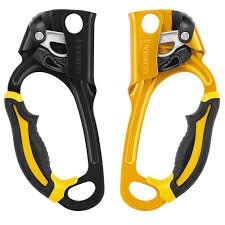“People need to know that they have all the tools within themselves. Self-awareness, which means awareness of their body, awareness of their mental space, awareness of their relationships - not only with each other, but with life and the ecosystem.”
“...but if that fails there’s always Elevated Climbing and OnRope 1.”
caving gear
On my very first wild caving trips I wore old jeans and a sweatshirt, a bicycle helmet with a cheap headlamp, and carried an old book bag from high school to carry food, water, and a couple of spare flashlights. The total investment in specialized gear was negligible. Now I have many sets of caving-specific coveralls, several premium LED headlamps, elaborate vertical caving kits, and high-tech digital survey equipment. The gear used in caving, as with almost any sport, is a means to an end. Choosing the right gear for the cave that’s being visited, the conditions you’re likely to encounter, the length of trip you plan to take, and the activities you’ll be engaging in, will enhance your effectiveness and enjoyment of the trip. For some cavers there is great joy that comes with researching and buying new gear, while for others they would rather someone else do this work and just recommend what harness or cave pack they should get. This section of the website will contain information that is part tutorial, part review, but any view or opinion is purely my own personal bias, and none of the content is paid for or sponsored by a gear manufacturer or retailer.
caving gear storage and organization
There is a certain amount of inertia that must be overcome to get out of your house or apartment and get underground. There are endless excuses or reasons for not getting out and caving, but very seldom do any of us look back and wish we hadn’t gone. I have found that by cleaning and organizing my caving gear following each trip it takes away many of the excuses. By using pre-trip checklists, keeping batteries fully charged, and putting gear in a place where it’s easy to find and pack, I can be ready for almost any trip or expedition on very short notice and I’m free to make spontaneous decisions. I use the utility room in my basement to organize gear and I prefer to store things on hooks or open shelves rather than in closed bins. The video below is a tour of my gear storage system.
helmets
Helmets serve a multitude of purposes. They protect your head from low ceilings, from falling rocks, and from impacts during a fall. They also provide a place to mount a headlamp. For most cavers an ABS hardshell or hardshell / foam hybrid helmet will be the best choice.
headlamps
A helmet-mounted, hands-free headlamp is one of the very fundamental pieces of caving gear. There are a myriad of options from under $20 to over $1000.
cave packs
For most types of cave trips there is a need to have a way to carry extra gear that won’t fit in your pockets. A rugged pack that will survive water, mud and abuse is critical to caving.
harnesses
A harness is the central piece of vertical caving gear. All ascending and descending equipment is attached to the caver through the harness. Cavers often use simple harnesses that lack padding and are designed to be abrasion resistant.
Ascenders
Ascenders, or rope grabs, come in a variety of forms. Some have handles, others do not. Some open to the side, while others surround the rope. They are designed to be easily moved up the rope, but to grab and hold tight when pulled back down. They are critical for climbing rope or holding the rope as part of a haul system.
Descenders
Descenders, or rappel devices, apply friction to the rope to control rate of descent. The most common devices used for caving are the bobbin and brake bar rack.
Stoves
While not a necessary piece of gear for most day-trips, an invaluable item on multi-day expeditions, and useful in cold alpine caves.
knives
Critical for rigging to cut ropes to length or remove old webbing or cord. Also a great tool for preparing lunch.








